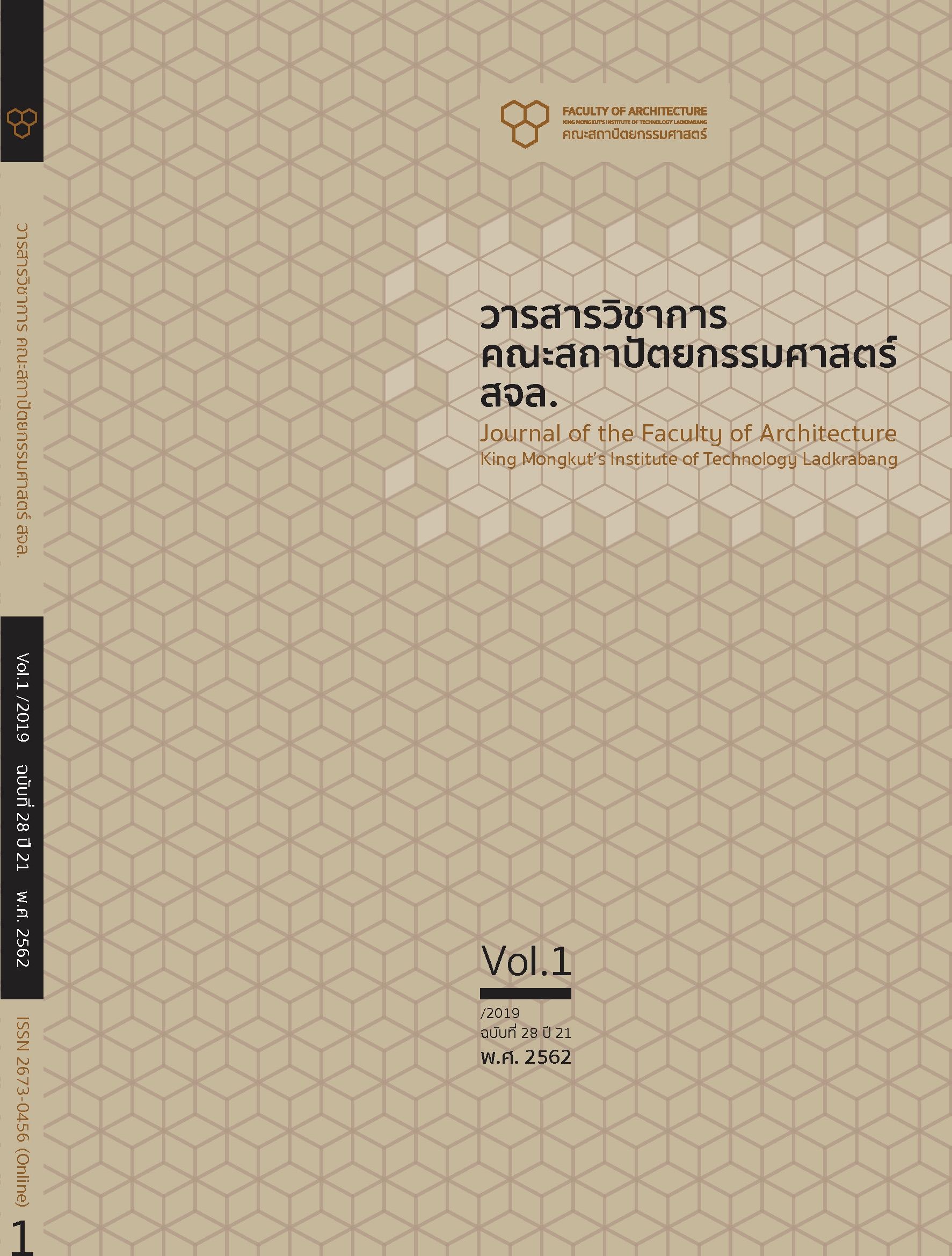Upcycling Kaolin Residue into Stone-Like Decorative Coating on Wall for Interior Decoration
Main Article Content
Abstract
บทคัดย่อ
กากดินขาวเป็นของเสียจากอุตสาหกรรมเหมืองแร่และเซรามิก ในจังหวัดลำปางมีปริมาณถึงกว่า 240,000 ตันต่อปี ที่ถูกปล่อยสู่สิ่งแวดล้อม ทำให้เกิดการปนเปื้อนในดิน นำไปสู่ความขัดแย้งในการใช้พื้นที่งานวิจัยนี้จึงวัตถุประสงค์เพื่อเสนอวิธีการเพิ่มมูลค่ากากดินขาว โดยใช้กากดินขาวเป็นมวลรวมในชั้นตกแต่งผนังคล้ายหิน กากดินขาวขนาดต่าง ๆ จะผสมกับตัวประสานพอลิเมอร์สามชนิดซึ่งได้แก่ พอลียูรีเทนซิลิโคนและอิพ็อกซี่ ในอัตราส่วนที่กำหนด ศึกษาเชิงเปรียบเทียบต่อลักษณะทางกายภาพ ความต้านทานแรงดึง ความแข็งแรงในการยึดเกาะและพฤติกรรมการดูดซับแสงของชั้นตกแต่ง ผลทดสอบพบว่ากากดินขาวผสมพอลิยูรีเทน มีค่าต้านทานแรงดึงอยู่ระหว่าง 0.68 – 1.88 เมกกะปาสคาลและมีค่าความแข็งแรงในการยึดเกาะอยู่ระหว่าง 0.31 – 0.76 เมกกะปาสคาล กากดินขาวผสมซิลิโคนมีค่าต้านทานแรงดึงอยู่ในช่วงระหว่าง 0.18– 0.35 เมกกะปาสคาล และมีความแข็งแรงในการยึดเกาะระหว่าง 0.07–0.10 เมกกะปาสคาลขณะที่ชั้น ตกแต่งผนังซึ่งใช้กากดินขาวผสมอิพ็อกซี่ มีค่าต้านทานแรงดึงอยู่ในช่วงระหว่าง 2.05–15.36 เมกกะปาสคาล และมีค่าแข็งแรงในการยึดเกาะอยู่ระหว่าง 1.30–2.13 เมกกะปาสคาล ชั้นตกแต่งทั้ง สามชนิดมีการดูดซับของแสงที่ 485 นาโนเมตร ทำให้ชั้นตกแต่งคล้ายหินมีลักษณะลวดลายเฉดสีส้ม ความเข้มสีและผิวสัมผัสคล้ายหินมากขึ้นเมื่อผสมกากดินขาวที่มีขนาดใหญ่ขึ้น และมวลรวมแต่ละชนิดสามารถใช้ขึ้นรูปชั้นตกแต่งผนังคล้ายหินได้ที่อุณหภูมิห้อง
จากงานวิจัยนี้ สรุปได้ว่าชั้นตกแต่งที่ใช้กากดินขาวผสมกับอิพ็อกซี่ เหมาะแก่การผลิตชั้นตกแต่งผนังคล้ายหินมากที่สุด นอกจากนี้ ใช้กากดินขาวที่มีขนาดมากกว่า 425 ไมครอน เป็นมวลรวมจะได้ชั้นตกแต่งที่มีสีและลวดลายคล้ายหินมากที่สุด การใช้กากดินขาวเป็นมวลรวมสำหรับชั้นตกแต่งผนังคล้ายหินเป็นวิธีหนึ่ง ในการเพิ่มมูลค่าให้กับกากดินขาว
คำสำคัญ: การเพิ่มมูลค่า กากดินขาว ชั้นตกแต่งคล้ายหิน
Abstract
Kaolin residue is the waste retrieved from mining and ceramic industry in Lumpang province. Kaolin waste is annually generated more than 240,000 tons and then discharged to the environment, contaminating the soil leading to conflicts of land-use. Therefore, this research aims to propose upcycling kaolin residue into aggregate in stone-like decorative coatings. In this project, Lumpang kaolin residue with different particle sizes was simply mixed with three different polymeric binders including polyurethane (PU), silicone and epoxy, into the designed compositions to form decorative coatings. Subsequently, comparative studies on physical properties, tensile strength, adhesive strength and visible light absorption behavior of the obtained coatings were conducted. Regarding mechanical properties, it was found that tensile strength of the decorative coatings produced by mixing polyurethane and kaolin residue lay between 0.68 and 1.88 MPa and the adhesion strength lay between 0.31 and 0.76 MPa. Concerning silicone as a binder, the coatings obtained from combination of kaolin residue and silicone exhibited a low tensile strength which ranged from 0.18 to 0.35 MPa, while adhesion strength was between 0.07 and 0.10 MPa. In regard to epoxy, the decorative layers showed the highest tensile strength lying between 2.05 and 15.36 MPa, whereas the adhesion strength ranged from 1.30 - 2.13 MPa. Light absorption behavior was also investigated. It was found that all the studied coatings showed a similar absorption behavior. Surface of the decorative coatings absorbed visible light at wavelengths near 485 nm, which therefore made the coating surface exhibit orange stone texture. In addition, it was observed that the surface color turned deeper and the stone texture became sharper when kaolin residue with larger particles was used. All of the decorative layers could be successfully formed at room temperatures. In conclusion, combination of epoxy and kaolin residue is most suitable for production of stone-like decorative coatings for wall decoration. Moreover, stone-like decorative coatings can be successfully obtained using kaolin residue aggregate with particle sizes larger than 425 microns. The utilization of kaolin residue as an aggregate for stone-like decorative coating can be value-added approach for kaolin residue.
Keywords: Upcycling, Kaolin Residue, Stone-like Decorative Coating
Article Details
This work is licensed under a Creative Commons Attribution-NonCommercial-ShareAlike 4.0 International License.
Copyright Transfer Statement
The copyright of this article is transferred to Journal of The Faculty of Architecture King Mongkut's Institute of Technology Ladkrabang with effect if and when the article is accepted for publication. The copyright transfer covers the exclusive right to reproduce and distribute the article, including reprints, translations, photographic reproductions, electronic form (offline, online) or any other reproductions of similar nature.
The author warrants that this contribution is original and that he/she has full power to make this grant. The author signs for and accepts responsibility for releasing this material on behalf of any and all co-authors.
References
เกษสุดา ดอนเมือง. (2558). การศึกษาปัจจัยที่มีผลกระทบต่อคุณภาพของดินที่ใช้ในอุตสาหกรรมเซรามิก. เข้าถึงได้จาก: https://library.dip.go.th/multim6/ebook/2559/DIP%20%E0%B8%81%E0%B8%AA%E0%B8%AD5%20%E0%B8%81101%E0%B8%82.pdf.
ธิติมา คุณยศยิ่ง , ศิริมา เอมวงษ์, ไพฑูรย์ เกิดพร้อม และแวอิเลียส บินโซดาโอะ. (2552). การศึกษาการลดน้ำหนักเนื้อดินสำหรับการประดิษฐ์เครื่องประดับเซรามิก โดยการเติมวัสดุชนิดเผาไหม้ได้. วารสารวิชาการคณะเทคโนโลยีอุตสาหกรรม มหาวิทยาลัยราชภัฏลำปาง. 2(1), 50-61.
พลยุทธ ศุขสมิติ, วิวัฒน์ โตธิรกุล, วรลักษณ์ เพชรรักษ์, สุทธินี จารุมาศ, อมรรัตน์ ร่มพล, ยงยุทธ นพนิช และทิวา พวงไสว. (2559). โครงการศึกษาวิจัยประสิทธิภาพการทำเหมืองแร่และการแต่งแร่ดินขาว จังหวัดลำปาง. สำนักงานอุตสาหกรรมพื้นฐานและการเหมืองแร่ เขต 3. เข้าถึงได้จาก: https://library.dmr.go.th/Document/DMR_Technical_Reports/2559/1969.pdf.
อดุลย์ ทรายตัน. (2558). ประโยชน์ของกากดินขาวลำปางต่อสมบัติเชิงกลของเนื้อดินเอิร์ทเทินแวร์ (USE OF LAMPANG WHITE CLAY RESIDUAL FORMECHANICAL PROPERTY OF EARTHENWARE CLAY). วารสารมหาวิทยาลัยศรีนครินทรวิโรฒ (สาขาวิทยาศาสตร์และเทคโนโลยี). 6(12), 163-175.
Brasileiro, M. I., Rodrigues, A. W. B., Menezes, R. R., Neves, G. A., and Santana, L. N. L. (2012). The Kaolin Residue and Its Use for Production of Mullite Bodies. Retrieved from: https://www.researchgate.net/publication/221926193_The_Kaolin_Residue_and_Its_Use_for_Production_of_Mullite_Bodies.
Callister, D. C. and Rethwisch, D. G. (2014). Materials Science and Engineering. 9th ed. New York: Wiley.
Dodsworth, S. (2009). The Fundamentals of Interior Design. New York: Boomsbury Publishing.
Garcia, F. G., Leyva, M. E., Queiroz, A. A. A., and Simões, A. Z. (2011). Durability of adhesives based on different epoxy/aliphatic amine networks. International Journal of Adhesion and Adhesives. 31(4),177-181.
German, R. (2014). Chapter Two - History of Sintering.In R. M. German (Ed.), Sintering: from Empirical Observations to Scientific Principles. (pp. 13-40). Boston: Butterworth-Heinemann.
Heath, D. and Cooper, S. (2013). A - Polyurethanes. In B. D. Ratner, A. S. Hoffman, F. J. Schoen, and J. E. Lemons (Eds.). Biomaterials Science. 3rd ed. (pp. 79-82). California: Academic Press.
Hughes, S. (2009). Chapter 6 - Non-destructive and Destructive Testing. In S. E. Hughes (Ed.), A Quick Guide to Welding and Weld Inspection. (pp. 67-87). New York: Woodhead Publishing.
Jin, F., Li, X., and Park, S. (2015). Synthesis and application of epoxy resins: A review. Journal of Industrial and Engineering Chemistry. 29, 1-11.
Patterson, R. (1998). 9 - Silicones. In S. H. Goodman (Ed.). Handbook of Thermoset Plastics. 2nd ed. (pp.468-497). Westwood, NJ: William Andrew Publishing.
Reghunadhan, A., and Thomas, S. (2017). Chapter 1 - Polyurethanes: Structure, Properties, Synthesis, Characterization, and Applications. In S. Thomas, J. Datta, J. T. Haponiuk, and A. Reghunadhan (Eds.). Polyurethane Polymers. (pp. 1-16). Amsterdam: Elsevier.

